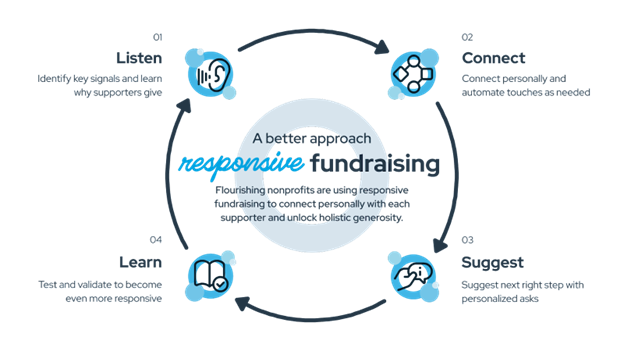The year-end giving season is rife with opportunities for new donor acquisition and for bringing in different types of donors. While we may have just closed another year’s chapter, the work is far from over. Now is the time to build and refine your donor retention strategies to ensure that these year-end donors remain engaged and committed to your cause.
Whether you launched a full-blown end-of-year campaign or didn’t send out appeals at all, the inherent generosity of the holidays inevitably attracted donors to your cause. After all, organizations can raise up to 31% of online revenue in December, as reported by M+R Benchmarks.
Even though many nonprofits use the season as an acquisition tool, it’s an even bigger opportunity to retain the long-term support of year-end donors. Equipped with a list of new and returning donors who recently made a gift, you know that these donors already have the intent to give—or they wouldn’t have given to your nonprofit in the first place!
Reducing attrition by retaining year-end donors
To prevent attrition, many nonprofits double down on donor acquisition efforts. However, this comes at a higher cost, as acquiring a new donor can be five times more expensive than retaining an existing one.
Allowing lapsed donors to fall through the cracks without attempting to re-engage them creates a vicious cycle. While acquisition should still be a part of a diversified fundraising strategy, if you want to reduce attrition, focus on retaining the support of those already in your donor file.
Donor retention is a core component of a responsive fundraising strategy. It goes beyond securing financial contributions—responsive fundraising is a strategic approach that fosters ongoing commitment and engagement among donors.
To forge lasting connections with donors and maintain their ongoing support, building off the responsive fundraising framework is essential. This approach combines modern technology, data intelligence, and donor-centric giving experiences, creating a dynamic strategy that adapts to the evolving needs and preferences of supporters.

Elevating your retention strategies with segmentation
Improving retention takes more than creating a generic strategy meant to be mass-communicated to every type of supporter. Considering their place in the donor journey, the responsive approach curates personalized messaging that deeply resonates with different types of donors. This is where donor segmentation makes all the difference.
By categorizing year-end donors into distinct segments based on factors like past giving history, interests, and engagement level, you have the opportunity to create targeted interactions. This allows you to send more relevant communications, provide tailored engagement opportunities, and strengthen the connection between year-end donors and your mission.
Recognizing the significance of thoughtful segmentation, the Norwescap team strategically categorized their donors into specific segments. This approach empowered the development team to include details such as the timing of the last donation and specific gift amounts, tailored to each type of donor.
“If [donors] had given in the last year, we talked to their recent support, and if they hadn’t, we reminded them in the letter. We used merge tags to include the date of when their last gift was given to help personalize it further,” says Heather Thompson, Chief Development Officer at Norwescap.
Different types of donors and how to retain them
Each of your donors deserves more than a one-size-fits-all approach. That’s why tailoring your retention strategies to the different types of donors is essential.
While you may want to expand upon this list, let’s explore the primary year-end donor types and what you can do to retain their support.
First-time donors
First-time donors represent a crucial opportunity for long-term engagement. With these donors, first impressions matter. At a minimum, acknowledge their contribution promptly with personalized thank-you messages.
Then, we recommend creating a welcome series so that they can better get to know your mission and its values, encouraging a second gift down the road.
Here’s an example of a welcome series to help get you started:
- Get to know us: Send first-time donors an email explaining the history behind your organization, what your mission and values are, and how you’re making a difference.
- What happens behind the scenes: This is your chance to share even more about your organization. Let them meet some of the people on your team and maybe even offer up a virtual tour of your facilities and programs.
- Your gift in action: What were you able to accomplish with their gift? Small or big, every gift matters. This is your opportunity to foster a deeper connection with donors by letting them know what their gift went toward and sharing individual stories of impact.
- Sign up for our newsletter: With access to insider updates, exclusive content, and sneak peeks into upcoming projects and initiatives, these donors will feel compelled to sign up for your newsletter.
- Make an even bigger impact: Don’t be afraid to make another ask. Encourage them to donate a second gift and let them know what that gift will go toward.
Second-time donors
Second-time donors have shown a deeper commitment to your cause by providing an additional gift. They likely have done additional research on your organization and know more about your organization than your first-time donors.
Think about the ways you can strengthen this connection, such as:
- Demonstrating the impact of their contributions
- Inviting them to participate in exclusive events or programs
- Targeting communications based on their interests and passions
- Encouraging them to sign up for your monthly giving program
Recaptured donors
If you have recaptured donors on your file from year’s end, congrats are in order! This re-engagement is a significant achievement. Now, it’s essential to build on this success by maintaining a strong and personalized connection.
Similar to first-time and second-time donors, express sincere gratitude for their ongoing support through tailored communications, and don’t forget to share compelling stories of impact, illustrating the difference their contributions have made.
This consistent, personalized, and engaging communication approach ensures that recaptured donors feel integral to the ongoing success of your mission.
Non-monetary donors
During the year-end season, you may have attracted the attention and generosity of non-monetary donors. Instead of contributing financial donations, these donors either offered their time in volunteering, event participation, or in-kind gifts like food, clothing, or even high-value crypto.
These donors have a vested interest in your cause and have the potential to be your mega-supporters since they’re already thinking of out-of-the-box ways to support your cause. First, it’s essential to acknowledge and celebrate their unique contributions. Then, create a personalized communication plan that will foster their long-term support.
Outside of sharing the impact of their contributions, invite these donors into your community of supporters who are affecting real change. Engage them by offering exclusive opportunities for involvement, such as special volunteer events, behind-the-scenes access, or recognition programs to make them feel valued and connected to your cause.
Streamline personalized retention through marketing automation
The level of personalization that these retention strategies require might seem out of reach for nonprofits, especially since they have limited resources compared to their for-profit counterparts. However, by harnessing the capabilities of responsive nonprofit CRM and marketing automation tools, nonprofits can streamline communication workflows and customize messages based on individual donor profiles, behaviors, and preferences.
Through automation, responsive nonprofits empower themselves to create multichannel and personalized experiences using fewer resources, transforming each interaction into an opportunity for meaningful connection.
For a deeper dive into donor retention and how automation facilitates this level of personalization at scale, read our comprehensive guide on donor retention.
About Virtuous
Much more than a nonprofit CRM, Virtuous is the only responsive fundraising platform designed to help nonprofit teams build better donor relationships and increase impact with confidence. Virtuous helps unify fundraising, marketing, and donor development activities, ridding teams of redundant back-office tasks, and surfacing the insights and signals needed to deliver dynamic donor experiences at scale. Learn more at virtuous.org.
About the Author

Stephen Boudreau serves as VP of Product and Content Marketing at Virtuous. For over two decades, he has helped nonprofits leverage the digital space to grow their impact. To that end, Stephen co-founded RaiseDonors, a platform that provides nonprofits with technology and experiences that remove barriers to successful online fundraising. He is an avid (but aging) soccer player, audio book enthusiast, and the heavily-disputed UNO champion of his household.









